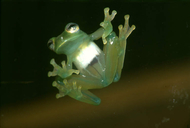|
Teratohyla spinosa (Taylor, 1949)
Dwarf Glassfrog, Minute Spiny Glassfrog, Rana de Cristal Enana, Rana de Cristal espinosa | family: Centrolenidae subfamily: Centroleninae genus: Teratohyla |
 © 2006 Dr. Peter Janzen (1 of 24) |
|
|
|
Description Diagnosis: Small uniformly green frog that can be distinguished by a free prepollex at the base of the thumb with an exposed spine in adult males, a round to truncate snout in profile, dark green bones, and only the parietal peritoneal sheath and heart white (Savage 2002). Description: This rarely seen small frog has a snout vent length ranging from 17.8 mm to 20 mm in adult males and 20 mm to 23 mm in adult females. The head is as wide as long and appears truncated in profile and semicircular in outline. The eyes are large and protuberant, and the interorbital space between is larger than the diameter of the eyes. The snout has a subovoid outline and appears truncated. The tympanum is indistinct and is directed obliquely upward. Vomerine teeth are present in two small patches that are widely separated and immediately medial to the choanae. The body shape is small and slender. The dorsal skin is granular in texture. Finger and toe discs are truncated. Fingers have small subarticular tubercles but no supernumerary tubercles. Accessory palmar and plantar tubercles are present. Finger I is longer than Finger II; vestigial webbing is present between these two fingers. More substantial webbing exists between the outer fingers in the pattern II 2-3 III 2 - 1 3/4 IV. Toes are moderately webbed, described as I 1-2 II 1-2 III 1-2 IV 2-1 V. An elongated inner metatarsal tubercle is present, but the outer metatarsal tubercle is lacking. No inner tarsal fold. Males possess a white nuptial pad on the lateral margin and dorsal of the thumb base. Frogs of this species possess a free prepollex. In larger males the prepollical spine projects externally (Savage 2002). The coloration is uniformly green on the dorsum, with white pigmentation on the undersides of limbs. The iris is gray-ivory with a black reticulum. This species has dark green bones and a white heart (Savage 2002). Distribution and Habitat Country distribution from AmphibiaWeb's database: Colombia, Costa Rica, Ecuador, Honduras, Nicaragua, Panama
Life History, Abundance, Activity, and Special Behaviors Teratohyla spinosa females lay 18-25 green eggs on the underside of vegetation in a single layer of loose jelly. The eggs and capsules together are 5 to 7 mm in diameter. While embryos appear gray upon hatching, they develop light brown upper-sides and paler under-sides in later stages. Juvenile frogs are 16 mm in standard length when first metamorphosed (Savage 2002). Trends and Threats Comments A Spanish-language species account can be found at the website of Instituto Nacional de Biodiversidad (INBio).
References
Cisneros-Heredia, D. F. (2009). ''Amphibia, Anura, Centrolenidae, Chimerella mariaelenae (Cisneros-Heredia and McDiarmid, 2006), Rulyrana flavopunctata (Lynch and Duellman, 1973), Teratohyla pulverata (Peters, 1873), and Teratohyla spinosa (Taylor, 1949): Historical records, distribution extension and new provincial record in Ecuador.'' Check List. Journal of Species Lists and Distribution, 5, 912-916. Cisneros-Heredia, D. F., and McDiarmid, R. W. (2005). ''Amphibia, Centrolenidae, Centrolene peristictum, Centrolene prosoblepon, Cochranella cochranae, Cochranella midas, Cochranella resplendens, Cochranella spinosa, Hyalinobatrachium munozorum: range extensions and new provincial records.'' Check List. Journal of Species Lists and Distribution, 1, 18-22. Cisneros-Heredia, D. F., and McDiarmid, R. W. (2007). ''Revision of the characters of Centrolenidae (Amphibia: Anura: Athesphatanura), with comments on its taxonomy and the description of new taxa of glassfrogs.'' Zootaxa, 1572, 1-82. Coloma, L. A., Ron, S., Wild, E., Cisneros-Heredia, D., Solís, F., Ibáñez, R., Jaramillo, C., Chaves, G., Savage, J., Cruz, G., Wilson, L. D., Köhler, G., Kubicki, B., and Berlin, E. (2008). Cochranella spinosa. In: IUCN 2010. IUCN Red List of Threatened Species. Version 2010.1. www.iucnredlist.org. Downloaded on 05 May 2010. Ibañez, R., Rand, A. S. and Jaramillo, C. A. (1999). Los Anfibios del Monumento Natural Barro Colorado, Parque Nacional Soberanía y Areas Adyacentes. Mizrachi, E. and Pujol, S. A., Santa Fe de Bogota. Kubicki, B. (2007). Glass Frogs of Costa Rica/ Rana de Vidrio de Costa Rica. Editorial INBio, Costa Rica. McCranie, J. R. (2007). ''Distribution of the amphibians of Honduras by departments.'' Herpetological Review, 38(1), 35-39. McCranie, J. R., and Wilson, L. D. (2002). ''The Amphibians of Honduras.'' Contributions to Herpetology, Vol 19. K. Adler and T. D. Perry, eds., Society for the Study of Amphibians and Reptiles, Ithaca, New York. Ruiz-Carranza, P.M., Ardila-Robayo, M.C., and Lynch, J.D (1996). ''Lista actualizada de la fauna de Amphibia de Colombia.'' Revista de la Academia Colombiana de Ciencias Exactas, Físicas y Naturales, 20(77), 365-415. Savage, J. M. (2002). The Amphibians and Reptiles of Costa Rica:a herpetofauna between two continents, between two seas. University of Chicago Press, Chicago, Illinois, USA and London. Sunyer, J. and Kohler, G. (2007). ''New country and departmental records of herpetofauna in Nicaragua.'' Salamandra, 43, 57-62. Sunyer, J., Páiz, G., Dehling, D. M., and Köhler, G. (2009). ''A collection of amphibians from Río San Juan, southeastern Nicaragua.'' Herpetology Notes, 2, 189-202. Taylor, E. H. (1949). ''Costa Rican frogs of the genera Centrolene and Centrolenella.'' University of Kansas Science Bulletin, 33, 257-270. Originally submitted by: Alexis Leigh Krup (first posted 2009-09-17) Edited by: Kellie Whittaker (2019-03-06) Species Account Citation: AmphibiaWeb 2019 Teratohyla spinosa: Dwarf Glassfrog <https://amphibiaweb.org/species/1799> University of California, Berkeley, CA, USA. Accessed May 23, 2025.
Feedback or comments about this page.
Citation: AmphibiaWeb. 2025. <https://amphibiaweb.org> University of California, Berkeley, CA, USA. Accessed 23 May 2025. AmphibiaWeb's policy on data use. |



 Map of Life
Map of Life